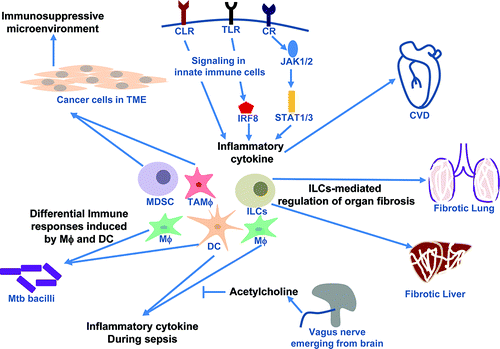The mammalian host immunity primarily depends on two kinds of barriers, the innate and adaptive immunity. These barrier consist of various cells and molecules which guard the host against various internal and external threats such as transformed cells and infectious agents, respectively. This issue of the International Reviews of Immunology focuses on the interactions between various cellular and molecular components of innate immunity in the modulation of infectious and non-infectious disease.
Multiple factors lead to uncontrolled cells division causing cancer. The abrupt cell division can be sensed and controlled by the immune system, through complex cellular and molecular interactions among the components of immunity and the cancer cell. In the first review, Okla et al., discusses tumor-associated macrophages (TAMs) and myeloid-derived suppressor cells (MDSCs) within tumor microenvironment (TME), and suggested that these cells possibly induce immunosuppressive microenvironment in ovarian cancer patients or initiate carcinogenesis. The authors also discussed the challenges associated with the investigation of TME and the benefits in overcoming these challenges in the development of diagnostics for ovarian cancer ().
FIGURE 1. Role of innate immune cells and pattern recognition receptors-mediated signaling pathway in infectious and non-infectious disease. TME: Tumor microenvironment; MDSC: Myeloid-derived suppressor cells; TAMφ: tumor-associated macrophages; Mtb: Mycobacterium tuberculosis; Mφ: Macrophages; DC: Dendritic cells; ILC: different types of Innate Lymphoid Cells; NK cells: Natural killer cells; CLR: C-type lectin receptors; TLR: Toll-like receptors; CR: cytokine recptors; JAK: Janus kinase; STAT: Signal transducer and activator of transcription; IRF; Interferon regulatory factor; and CVD: Cardiovascular disease.

Although tuberculosis is an ancient disease infecting one-third world population, it is essential to understand the molecular mechanisms of host-Mycobacterium tuberculosis (Mtb) interaction for the development of new therapeutics, especially due to the emergence of drug-resistant Mtb which is going to be one of the most severe future threat to the human. In the second review, Khan et al. highlights the importance of two distinct types of key innate immune cells namely macrophages and dendritic cells against Mtb. Furthermore, the review also discusses different countermeasures adopted by the Mtb against these cells for immune evasion ().
Diverse cell types constitute a unique group of cells known as Innate Lymphoid Cells (ILCs) which play a pivotal role in various infection, tumor, tissue injury and maintenance of tissue homeostasis after infection through coordination of innate and adaptive immune cells and molecules. In the third article, Zhang et al. discuss the mechanism of ILCs-mediated regulation of lung and liver fibrosis and projected its importance to translational immunology against fibrotic diseases ().
The communication between nerve signaling and immune cell signaling, and its outcome at molecular level, are a poorly understood area of neuro-immunology. In the fourth article, Wang et al. provides the molecular basis of the “Inflammatory Reflex.” This phenomenon is characterized by inhibition of inflammatory cytokines by acetylcholine (produced at nerve ending during nerve stimulation) due to the expression of a type of acetylcholine receptor on innate immune cells. The authors also discussed the potential of the inflammatory reflex in therapeutic intervention against sepsis through modulation of nerve signaling ().
The Cardiovascular Disease (CVD) is responsible for major proportion of deaths in developed and developing countries and associated with poor lifestyle and food habits. In the last review article, Chmielewski et al. discusses the interplay of transcription factors such as Signal Transducer and Activator of Transcription-1 (STAT1) and Interferon Regulatory Factor-8 (IRF8), key transcription factors in various innate and adaptive immune responses. The review also discusses the cross-talk between pro-inflammatory cytokine and Toll-like Receptor (TLR4) in CVD and suggested a potential in diagnosis and therapeutics. However additional work is required before taking this concept to the next step ().
Next issues of the journal will focus on a broad range of topics including Protein structure, cellular metabolism, and genetics in immunity.
REFERENCES
- Okla K, Wertel I, Po9lak G, Surówka J, Wawruszak A, Kotarski J. Tumor-associated macrophages and myeloid-derived suppressor cells as immunosuppressive mechanism in ovarian cancer patients: Progress and challenges. International Reviews of Immunology 2016;35(5):372–386.
- Khan N, Vidyarthi A, Pahari S, Agrewala JN. Distinct strategies employed by dendritic cells and macrophages in restricting mycobacterium tuberculosis infection: Different philosophies but same desire. International Reviews of Immunology 2016;35(5):387–399.
- Zhang Y, Tang J, Tian Z, van Velkinburgh JC, Song J, Wu Y, Ni B. Innate lymphoid cells: A promising new regulator in fibrotic diseases. International Reviews of Immunology 2016;35(5): 400–415.
- Chmielewski S, Piaszyk-Borychowska, Wesoly J, Bluyssen HAR. STAT1 and IRF8 in vascular inflammation and cardiovascular disease: Diagnostic and therapeutic potential. International Reviews of Immunology 2016;35(5):434–454.
- Wang D-W, Yin Y-M, Yao Y-M. Vagal modulation of the inflammatory response in sepsis. International Reviews of Immunology 2016;35(5):416–433.

